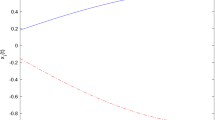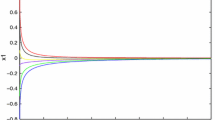Abstract
In this paper, an original scheme is presented, in order to study the finite-time stability of the equilibrium point, and to prove its existence and uniqueness, for Caputo–Katugampola fractional-order neural networks, with time delay. The proposed scheme uses a newly introduced fractional derivative concept in the literature, which is the Caputo–Katugampola fractional derivative. The effectiveness of the theoretical results is shown through simulations for two numerical examples.


Similar content being viewed by others
References
Price M, Glass J, Chandrakasan AP (2018) A low-power speech recognizer and voice activity detector using deep neural networks. IEEE J Solid-State Circuits 53(1):66–75
Gopinath B (2018) A benign and malignant pattern identification in cytopathological images of thyroid nodules using gabor filter and neural networks. Asian J Converg Technol. https://doi.org/10.33130/asian%20journals.v4iI.414
Li Y, Tong S (2017) Adaptive neural networks decentralized FTC design for nonstrict-feedback nonlinear interconnected large-scale systems against actuator faults. IEEE Trans Neural Netw Learn Syst 28(11):2541–2554
Rajchakit G (2017) Stability of control neural networks. Int J Res Sci Eng 3(6):22
Zhang XM, Han QL (2014) Global asymptotic stability analysis for delayed neural networks using a matrix-based quadratic convex approach. Neural Netw 54:57–69
Zhu Q, Cao J (2014) Mean-square exponential input-to-state stability of stochastic delayed neural networks. Neurocomputing 131:157–163
Chen X, Song Q (2013) Global stability of complex-valued neural networks with both leakage time delay and discrete time delay on time scales. Neurocomputing 121:254–264
Xu C, Chen L (2018) Effect of leakage delay on the almost periodic solutions of fuzzy cellular neural networks. J Exp Theor Artif Intell 30(6):993–1011
Xu C, Chen L, Li P (2019) Effect of proportional delays and continuously distributed leakage delays on global exponential convergence of CNNS. Asian J Control 21(5):1–8
Xu C (2018) Local and global Hopf bifurcation analysis on simplified bidirectional associative memory neural networks with multiple delays. Math Comput Simul 149:69–90
Xu C, Tang X, Li P (2018) Existence and global stability of almost automorphic solutions for shunting inhibitory cellular neural networks with time-varying delays in leakage terms on time scales. J Appl Anal Comput 8(4):1033–1049
Xu C, Li P (2018) On anti-periodic solutions for neutral shunting inhibitory cellular neural networks with time-varying delays and D operator. Neurocomputing 275:377–382
Xu C, Li P (2018) Global exponential convergence of fuzzy cellular neural networks with leakage delays, distributed delays and proportional delays. Circuits Syst Signal Process 37(1):163–177
Kamenkov G (1953) On stability of motion over a finite interval of time. J Appl Math Mech 17(2):529–540
Bhat SP, Bernstein DS (1998) Continuous finite-time stabilization of the translational and rotational double integrators. IEEE Trans Autom Control 43(5):678–682
Wang H, Zhu Q (2015) Finite-time stabilization of high-order stochastic nonlinear systems in strict-feedback form. Automatica 54:284–291
Mobayen S (2016) Finite-time stabilization of a class of chaotic systems with matched and unmatched uncertainties: an LMI approach. Complexity 21(5):14–19
Lu K, Xia Y (2015) Finite-time attitude stabilization for rigid spacecraft. Int J Robust Nonlinear Control 25(1):32–51
Engheta N (1996) On fractional calculus and fractional multipoles in electromagnetism. IEEE Trans Antennas Propag 44(4):554–566
Laskin N (2000) Fractional market dynamics. Phys A 287(3):482–492
Jmal A, Naifar O, Ben Makhlouf A, Derbel N, Hammami MA (2018) Observer-based model reference control for linear fractional-order systems. Int J Digit Signal Smart Syst 2(2):136–149
Jmal A, Naifar O, Ben Makhlouf A, Derbel N, Hammami MA (2018) Sensor fault estimation for fractional-order descriptor one-sided Lipschitz systems. Nonlinear Dyn 91(3):1713–1722
Ben Makhlouf A, Nagy AM (2018) Finite‐time stability of linear Caputo–Katugampola fractional-order time delay systems. Asian J Control. https://doi.org/10.1002/asjc.1880
Kaslik E, Sivasundaram S (2012) Nonlinear dynamics and chaos in fractional-order neural networks. Neural Netw 32:245–256
Bao HB, Cao JD (2015) Projective synchronization of fractional-order memristor-based neural networks. Neural Netw 63:1–9
Thuan MV, Huong DC, Hong DT (2018) New results on robust finite-time passivity for fractional-order neural networks with uncertainties. Neural Process Lett. https://doi.org/10.1007/s11063-018-9902-9
Thuan MV, Binh TN, Huong DC (2018) Finite-time guaranteed cost control of caputo fractional-order neural networks. Asian J Control 22(1):1–10
Peng X, Wu H, Song K, Shi J (2017) Global synchronization in finite time for fractional-order neural networks with discontinuous activations and time delays. Neural Netw 94:46–54
Peng X, Wu H, Cao J (2018) Global nonfragile synchronization in finite time for fractional-order discontinuous neural networks with nonlinear growth activations. IEEE Trans Neural Netw Learn Syst. https://doi.org/10.1109/TNNLS.2018.2876726
Peng X, Wu H (2018) Robust mittag-leffler synchronization for uncertain fractional-order discontinuous neural networks via non-fragile control strategy. Neural Process Lett 48(3):1521–1542
Liu M, Wu H (2018) Stochastic finite-time synchronization for discontinuous semi-Markovian switching neural networks with time delays and noise disturbance. Neurocomputing 310:246–264
Ran-Chao W, Xin-Dong H, Li-Ping C (2013) Finite-time stability of fractional-order neural networks with delay. Commun Theor Phys 60(2):189
Alofi A, Cao J, Elaiw A, Al-Mazrooei A (2014) Delay-dependent stability criterion of Caputo fractional neural networks with distributed delay. Discret Dyn Nat Soc. https://doi.org/10.1155/2014/529358
Ke Y, Miao C (2015) Stability analysis of fractional-order Cohen–Grossberg neural networks with time delay. Int J Comput Math 92(6):1102–1113
Yang X, Song Q, Liu Y, Zhao Z (2015) Finite-time stability analysis of fractional-order neural networks with delay. Neurocomputing 152:19–26
Xu C, Li P (2018) On finite-time stability for fractional-order neural networks with proportional delays. Neural Process Lett. https://doi.org/10.1007/s11063-018-9917-2
Katugampola UN (2011) New approach to a generalized fractional integral. Appl Math Comput 218(3):860–865
Katugampola UN (2014) A new approach to generalized fractional derivatives. Bull Math Anal Appl 6(4):1–15
Kilbas AA, Srivastava HH, Trujillo JJ (2006) Theory and applications of fractional differential equations. Elsevier, Amsterdam
Anderson DR, Ulness DJ (2015) Properties of the Katugampola fractional derivative with potential application in quantum mechanics. J Math Phys 56(6):063502
Wu H, Zhang X, Xue S, Wang L, Wang Y (2016) LMI conditions to global Mittag–Leffler stability of fractional-order neural networks with impulses. Neurocomputing 193:148–154
Wang LF, Wu H, Liu DY, Boutat D, Chen YM (2018) Lur’e Postnikov Lyapunov functional technique to global Mittag–Leffler stability of fractional-order neural networks with piecewise constant argument. Neurocomputing 302:23–32
Kuczma M (2009) An introduction to the theory of functional equations and inequalities: Cauchy’s equation and Jensen’s inequality. Springer Science & Business Media, Berlin
Mitrinovic ND (1970) Analytic inequalities. Springer, New York
Author information
Authors and Affiliations
Corresponding author
Ethics declarations
Conflict of interest
The authors declare that they have no conflicts of interest.
Additional information
Publisher’s Note
Springer Nature remains neutral with regard to jurisdictional claims in published maps and institutional affiliations
Rights and permissions
About this article
Cite this article
Jmal, A., Ben Makhlouf, A., Nagy, A.M. et al. Finite-Time Stability for Caputo–Katugampola Fractional-Order Time-Delayed Neural Networks. Neural Process Lett 50, 607–621 (2019). https://doi.org/10.1007/s11063-019-10060-6
Published:
Issue Date:
DOI: https://doi.org/10.1007/s11063-019-10060-6




